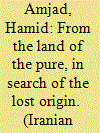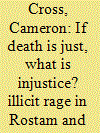|
|
|
Sort Order |
|
|
|
Items / Page
|
|
|
|
|
|
|
| Srl | Item |
| 1 |
ID:
137392


|
|
|
|
|
| Summary/Abstract |
The Tahmineh and Rostam episode, as presented in modern text-critical editions of Ferdowsi's Shahnameh, is compared vis-à-vis both the pre-modern scribal interventions in the manuscript tradition of the poem, as well as two oral presentations of the same episode by traditional storytellers (naqqālān), as preserved in their prompt-books (tumārs) and in recorded performances from the twentieth century. The mise-en-scène, the social circmstances, as well as the expansive nature of such oral performances, are described, and a translation of an oral version of the Rostam and Tahmineh episode is given. The narrative strategies employed to negotiate the intersection of new episodes or contemporary moralistic considerations with the written text of Ferdowsi's Shahnameh are then explored, analyzing the nature, motivations and functions of the scribal and oral interpolations to the Tahmineh episode, and demonstrating how modernizing reinterpretations impart a certain dynamism to the living Shāhnāmeh tradition. The naqqālān are shown to alter the Tahmineh episode to comply with the moral and religious values of their audiences, the requirements of extended narration cycles, and the horizon of expectation of the genre of epic. The article closes with a brief consideration of how moral and religious values apply differentially across various genres (heroic epic, romance, etc.), and how these differing horizons of expectation impact the reinterpretation of the narrative material.
|
|
|
|
|
|
|
|
|
|
|
|
|
|
|
|
| 2 |
ID:
126928


|
|
|
|
|
| Publication |
2013.
|
| Summary/Abstract |
The interview was conducted in 1997 after the publication of Beyzaie's extraordinary engagement with the legend of Siyavush in Siyavush-Khani (Siyavush Recitation). Beyzaie's experiments with Shahnameh legends are not adaptations in the strict sense of the term. This is primarily because their stories are often different from what appears in the Shahnameh, mix the narratives with other mythical sources and place them in contemporary templates with an inter-paradigmatic gaze that reflects on the meaning and the history of the present. The interview is significant in that, as it has been conducted by a leading playwright and scholar of Iranian performing arts, it enables the reader to have firsthand experience of working in Iran as a playwright and reveals some of the methods Beyzaie uses to handle his subjects.
|
|
|
|
|
|
|
|
|
|
|
|
|
|
|
|
| 3 |
ID:
137390


|
|
|
|
|
| Summary/Abstract |
This is a comparative study of anger and narrative control in two tragic stories cast in an epic-heroic register, the “Tale of Rostam and Sohrab” of Ferdowsi's Shahnameh and “The Knight's Tale” of Chaucer's Canterbury Tales. The narrators of both stories are heavily invested in upholding a certain normative interpretation of the events they recount, a fatalistic worldview that justifies itself through the necessarily agnostic optimism that these senseless catastrophes gain meaning when situated within a greater order that is beyond the capacity of man to comprehend. The emotional responses of outrage and grief therefore have no legitimate place in this worldview, and must be submitted to a process of rationalization and violent suppression in order to be kept in check. However, this same process also reveals the underlying aporias of its own normative logic, producing a subtextual counter-narrative that resists and undermines the dominant voice of the text. The resulting fragmentation and narrative collapse provides a fruitful opportunity to investigate how both texts respond to a crucial ontological topic in medieval literature and philosophy: what does it mean to be an autonomous subject within a divinely ordered universe, and how can one distinguish justice from tyranny in a world entirely governed by fate?
|
|
|
|
|
|
|
|
|
|
|
|
|
|
|
|
| 4 |
ID:
182065


|
|
|
| 5 |
ID:
137393


|
|
|
|
|
| Summary/Abstract |
This study examines the Jamshid of Ferdowsi's Shahnameh and its later reception, specifically the Islamic refashioning of Jamshid in fourteenth-century Shiraz, as evidenced in the ghazals of Hāfez (d. 1389), and the lyric poetry of Khvāju-ye Kermāni (d. 1352 or 1360), and ʿObeyd-e Zākāni (d. 1371). Hāfez, Khvāju, and ʿObeyd used literary devices such as talmih (allusion) and ubi sunt to both engage with and reshape the past, and this refashioning of the past was employed to legitimize their patrons’ authority to rule from Shiraz. The article culminates in an exploration of the mytho-political dimensions of the conflation of Jamshid with Solomon and the intimate association of this composite figure with Fars in the Ilkhanid and post-Ilkhanid periods. Poetry is treated here as a productive force that both shapes and is shaped by the socio-political circumstances of its composition, performance, and reception. In order to locate the thirteenth- and fourteenth-century reconfiguration of Jamshid within its geo-mythological context, use has been made of the concept of lieu de mémoire as a means through which to unpack the trans-historical cultural impact on Shiraz of the ancient Achaemenid and Sasanian ruins that surround the Islamic city; ruins that have for more than two millennia embedded a sense of proximity to history in the land and peoples of Fars.
|
|
|
|
|
|
|
|
|
|
|
|
|
|
|
|
|
|
|
|
|